Cool-climate tomato trials
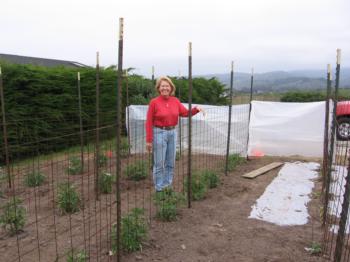
We tested a total of thirteen varieties of tomatoes – two plants each of 11 varieties purchased as small seedlings from Love Apple Farm on April 7, and one each of two additional varities (Silitz and Jetsetter) purchased in four-inch pots from Lumberman’s in Santa Cruz on April 7.
Tomato varieties tested
Amish Gold. 80 days. Indeterminate. Yellow-orange. Cross between Amish Paste and Sungold.
Black Krim. 75 days. Indeterminate. Purple-black. Originally from the Isle of Krim on the Black Sea in the former Soviet Union.
Cosmonaut Volkov Red. 72 days. Indeterminate. A Ukrainian heirloom variety with good-sized red fruit.
Costoluto Fiorentino. 80 DAYS. Indeterminate. Italian heirloom with good-sized bright red tomatoes.
Costoluto Genovese. 78 days. Indeterminate. Italian heirloom tomato with large, deep red fluted fruit.
Japanese Oxheart. 80 days. Indeterminate. Prolific plant, jade pink heart-shaped fruit.
Jaune Flammé. 70 – 80 days. Indeterminate. Small, deep orange heirloom from France.
Jetsetter. 64 days. Indeterminate. Medium-sized red slicers; disease resistant.
Moskovich. 60 days. Semi-determinate. An extra-early heirloom with deep red, 4-6 oz. fruit.
Mr. Brown. 79 days. Indeterminate. Medium-sized slicer with a beautiful chocolate color.
Purple Calabash. 85 days. A drought-tolerant variety with small, deeply ruffled, chocolate brown to deep purple fruit.
Siletz. 52 days. Determinate. Deep red round slicing tomato.
Taxi. 65-70 days. Determinate. Bright yellow, medium-sized fruits.
Can't wait? Skip to our results!
Up-potting
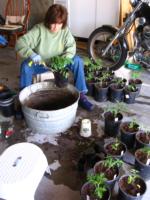
Plants grew rapidly and had set blossoms before being transplanted to Half Moon Bay (HMB). We think it is important to up-pot as soon as possible to enable the plants to grow large before transplanting. It is also important to give the plants strong daylight and nighttime protection if necessary.
Garden plot and preparation
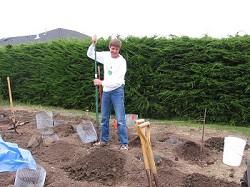
We constructed a gopher cage for each tomato plant. We used a roll of 1/2” x 1/2” galvanized wire mesh 4’ wide by 100’ long. We cut the wire into 2’ wide strips and wound it around a five-gallon paint bucket (serving as a frame), securing the wire cylinder with three black electric ties. We formed baskets by stepping on the wire to fold the bottom of the basket flat, creating a bottom.
The Soil Farm of Half Moon Bay delivered four cubic yards of well-aged mushroom compost on May 9. We spread the compost, sprinkled on fertilizer, and forked the amendments into the top 6” of soil. We dug 18” deep holes and sunk the gopher baskets into the ground. We pounded in four 10’ T-bars per row and attached the 4’ x 7’ cement reinforcing wire to provide a trellis for the tomatoes.
Planting
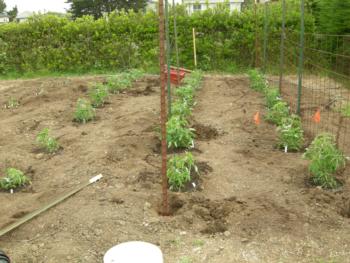
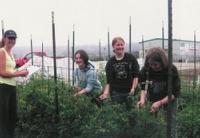
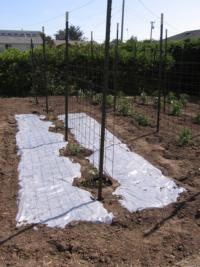
On August 27, we installed two drip lines per row, a few inches away from the baskets. The plants were watered with a timer, which worked well.
Problems
We aggravated the clay soil problem by amending only the soil in the gopher baskets, thus creating a “flower pot” effect – making watering (and drainage) difficult.
We were plagued with problems from aphids, gophers, and some early and late blight. It would probably have been wise to use light row cover to protect all of the plants from aphids. Additionally, we could have added to the plot some beneficial plants, for instance, yarrow, anise hyssop, dill, wild buckwheat (Eriogonum spp.), cosmos and many others.
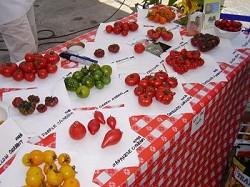
Despite problems, which surely limited production, our tomatoes did well and produced. We picked tomatoes and organized a Tomato Tasting at the HMB Farmer’s Market in September.
Results
Although we had some problems, we had success growing tomatoes in the coastal climate. The tomatoes ripened in September, much later than they would have in a warmer inland setting.
All of the tomatoes grown had thicker skin than the same tomato grown in a warmer climate. Also, most of the less successful tomato cultivars produced small, thick-skinned, but very intensely flavored fruit.
The plants covered with the floating row cover (Yellow Pear, Yellow Currant, Green Zebra, Maule's Earliest, and Early Girl) grew more rapidly, set more and earlier fruit, and suffered fewer aphid and blight problems than the four uncovered tomatoes.
The four successful tomato cultivars:
Black Krim. These large sprawling vines yielded four 3.5" fruits, four 2” fruits, and 4 marble-sized fruits on September 15. This tomato is slightly flattened, maroon with deep green shoulders and beautiful green gel around the seeds. This tomato produced more fruit and better flavored fruit than a Black Krim that Carol grew in San Mateo, albeit with thicker skin.
Jaune Flamme. These grow as tall wispy vines. One of these two plants produced 61 (!) fruits for the SM/SF MGs Tomato Tasting at HMB Farmer’s Market on September 15. Despite a vigorous aphid attack, this cultivar was quite productive over an extended period in the cool coastal climate of Half Moon Bay. It bore clusters of deep orange fruit the size and shape of small apricots. Very flavorful fruit, sweet as a strawberry.
Jetsetter. This vigorous, healthy, plant had floppy branches that become brittle at the end of the season. It yielded plenty of 2.5" fruits with a rich tomato taste and well-balanced flavor.
Taxi. This tiny, ugly bush was productive! One of these small plants produced 34 fruits from cherry size to 1.5” size. Tomatoes were bright yellow, smooth, meaty, mild, and acid free.
* These days to maturity are typical for warmer climates; in the cool coastal climate of Half Moon Bay, ripening took 100 to 120 days. This time period is approximately 35% to 50% longer than the days to maturity listed on seed packets. Gardeners growing tomatoes in this climate should select varieties with quick maturation times.
Special thanks to these Half Moon Bay businesses for their support of this research project:
Andreotti Family Farms
Rice Trucking & Soil Farm
